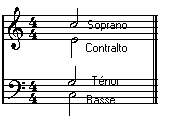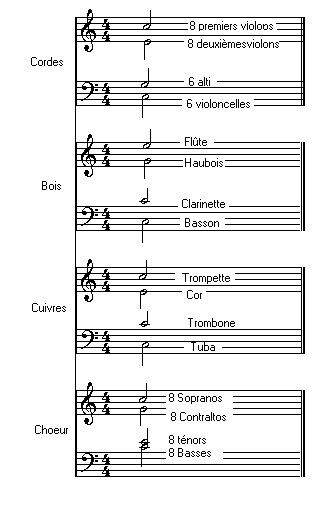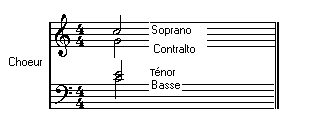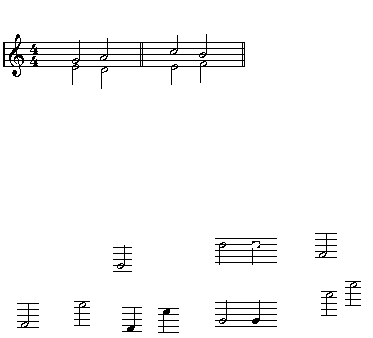Displaying the voices in a staff

In the next chapter, we will start our first harmony exercises, and we are going to learn how to compose (the word is not exaggerated) some exercises with four voices. Here are the last instructions before passing to the action.
In music, most of things are done with four voices. The parts with two or three voices as well as the parts with more than four voices are unusual, even in the modern symphonic music. The apparent complexity of an orchestra of eighty musicians or more is due only to the copies of the notes.
The following paragraphs (in small fonts) aren't a part of the chapter's essence. They must be considered as illustrations to understand how a big band can produce a great sonority with just a C-E-G chord.
Let's suppose an orchestra composed of 8 first violins, 8 second violins, 6 altos, 6 cellos, 4 basses, one flute, a piccolo flute, an oboe, a clarinet, a bassoon, a contrebassoon, a trumpet, a horn, a trombone, a tuba. Total : 42 musicians. Let's add a choir of 32 choristers, we have thus 75 musicians without considering the percussion.
We will make our orchestra playing a very simple C major chord (more precisely a first degree chord from C Major scale (that is to say C E G).
If we consider our orchestral diagram in the previous chapter, it appears like this. Those four voices represent the harmonic core.

It should be noted that, when you write with four voices, you must double a note when it is about some chords with three notes. Here, we doubled the root note (C). This is the harmonic core, this is studied in Harmony science. The following pictures are already belonging to the score.
This chord, orchestrated, is presented like that :

The same chord is arranged differently in the four groups.
Maybe that you want to stretch the chord on many more octaves. In this case, you double certain notes at octave. In general, you double the bass at the lower octave and one, two or three high voices to the upper octave.
NOTE : For some reasons of better understanding, I don't care about the transposition of the instruments. Besides, always write your rough copy with true notes. Do the transposition when you will write cleanly your music or for instrumental parts.
NOTE #2 : In DAW, if you want to double the melodies at octave, never use some samples containing some octaves, neither copy-pasting with transposition. Play again the melody at octave on an other track. Never quantize similarly both melodies or do a light dispersion. The interest of doubled notes, on top of extending the musical part on several octaves, is also to create the small imperfections which make your song living and give some realism to a synthetic score. Avoid any automatism.
NOTE #3 : The doubled notes techniques will be explained later. Those examples are only intended to illustrate how a big band produces a full sound with only C-E-G.
Scoring with four voices
We've seen that the voices are named, from top to bottom :
- Soprano
- Contralto
- Tenor
- Bass
They are distributed like this in a staff system.

Now we are going to have a look to an aspect a little bit arid of our study through necessary.
Motion of the voices
- When two voices move off or draw closer, this is called a contrary motion.
 Sketch 6dWhen two voices ascend or descend in the same direction, this is named a direct motion.
Sketch 6dWhen two voices ascend or descend in the same direction, this is named a direct motion. Sketch 6eIf the voices keep the same interval in a direct motion, it is about a stepwise motion.
Sketch 6eIf the voices keep the same interval in a direct motion, it is about a stepwise motion. Sketch 6fWhen a voice moves while the other one stays fixed or that the note is repeated itself, this is named an oblique motion.
Sketch 6fWhen a voice moves while the other one stays fixed or that the note is repeated itself, this is named an oblique motion. Sketch 6g
Sketch 6g
Harmony rules
Keep in mind that there are only five rules in Harmony. Starting from those five rules, you can discover alone the whole of harmony.
The confusion which reigns in the official teaching of Harmony makes believing that there are hundred and hundred rules which must be taken in care at a precise moment of the learning and which become out-dated later.
Some "rules" established by the official teaching are just some parapets to avoid to do certain errors which can happen when you don't have all the informations.
We will make the distinction between "rules" and "methods", methods being some "tips", allowing us to go ahead without making some errors or when you don't have still some ideas to make something original while respecting the five basic rules.
Any doubt that what will be shown in the following paragraphs won't have much significance for the beginners. I just ask to write them separately or to keep them in your mind. As we will progress in our study, their understanding will become more and more clear. We will start to do some exercises which do not require to practice those rules immediately because we will use some processes which will take this in care. Step by step, we will forget these "parapet" processes and we will use those rules more and more.
- Harmonic interval between the voices.
Between soprano and contralto, and between contralto and tenor, the maximum interval mustn't exceed one octave. Between tenor and bass, the interval is without limits.
- Melodic Interval.
As long as you stay in the harmonical situation of a same chord, the maximum melodic interval mustn't exceed one octave. When the chord changes, the maximum melodic interval is of a third, except if the skipping appears between two notes which have the same function in their respective chords, in this case the maximum melodic interval is of a sixth.
- Motion of the voices.
When the chord changes, avoid the direct motion, but this is possible in the context of the same chord.
- Forbidden motions.
Parallel octaves are forbidden. Parallel fifths are forbidden in the harmony with three notes.
- Resolving the leading notes and the dissonances.
If a leading note (there are two leading notes in the scale) is located on an important voice by its listening priority (Soprano or bass or in a solo melody), it must be resolved, except if a modulation (tonality change) comes to change its function. All the dissonances must be resolved.
Know however that the evolution of the styles makes certain notes loosing their dissonance specificity. This rule apparently much complex can be resumed like this : All the tensions must be resolved.
Note : As we will progress in the work, the contents of those five rules will become clearer and more and more essential. It will give on more some thought materials each time you will have to do with a harmonic problem.
Mario LITWIN, on the 21-11-1999 Page viewed 8223 times
Page viewed 8223 times




